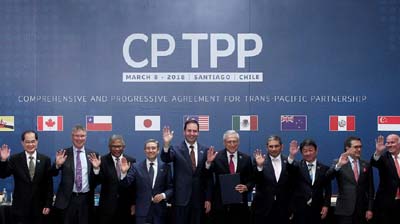
The world will benefit if China gains entry into CPTPP
James Gomez
China’s request to join the Comprehensive and Progressive Agreement for Trans-Pacific Partnership, or CPTPP, is no surprise. In November 2020, during an APEC summit, President Xi Jinping said that China would actively consider the possibility of joining the regional trade group. Developing countries would benefit from a rules-based international order that aids the post-pandemic economic recovery.
As of September 2021, the combined population of the CPTPP member countries —Australia, Brunei, Canada, Chile, Japan, Malaysia, Mexico, New Zealand, Peru, Singapore and Vietnam — was around 500 million (6.7 percent of the world’s population), and their overall GDP was roughly US$13.5 trillion (13.4 percent of global GDP). If China joins this trade bloc, it will enlarge the population to 1.9 billion (25 percent of the world’s population) and the combined GDP will rise to $25.3 trillion (30 percent of global GDP).
In comparison to the Regional Comprehensive Economic Partnership, or RCEP, where China is the main architect and the bloc represents the world’s largest free trade area — comprising 2.2 billion of the world’s population and a combined GDP of $26.2 trillion — one may rightfully ask what are the additional benefits of China’s move to join the CPTPP?
On the surface, it may seem that joining the CPTPP may provide China a means to defuse the ongoing economic conflict, the so-called trade war, with the United States, started by the former US president Donald Trump.
Citing the US’ view of China’s commercial practices — such as the provision of subsidies, preferential treatment towards state-owned enterprises, contested technology transfer practices, and unfair intellectual property practices — Trump imposed a series of tariffs on Chinese products starting from 2018.
But in reality, China may be signalling that it is, perhaps, ready to open up its SOEs to market forces and adjust practices to international standards of competition.
For instance, by adopting the CPTPP trade rules, China would in effect align its international trade policy to the international norms. Among these are reforms on state enterprises and better protection for intellectual property and trade secrets.
Some countries have cast doubts on the prospect of China committing to do so, arguing that SOEs would not be allowed to operate under market forces as this runs counter to state capitalism.
However, this does not mean that it could not happen. Just as China benefited considerably from the economic reform undertaken after its accession to the World Trade Organization, joining the CPTPP may prove to be another watershed moment for China’s economy. In essence, CPTPP could reduce the trade tension between China and the US by letting market forces come into play.
After several years of uncertainties in international politics, characterised by the re-emergence of unilateralism and protectionism, adverse economic effects have been felt across the world. Developing countries were the most severely affected as they had been relying on international trade to deliver economic growth. A rule-based, predictable competition can correct these uncertainties, allowing countries to look forward to the ‘new normal’ after the COVID-19 pandemic.
While different commentators may have different interpretations over China’s intention to join the CPTPP, a good policymaker would see an opportunity when there is one. Given that countries are slowly coming out of the lockdowns and resuming international travel to kick-start the post-pandemic economic recovery, it is important to support China’s application to join the CPTPP.
Given the sheer size of its economy, any major shocks such as the housing bubble, stock market crash or liquidity crisis will have implications on Asia-Pacific countries and the global economy.
Take the ongoing Evergrande crisis, for example. An eventual default by the second-largest Chinese real estate developer would hit China’s financial markets hard and, as a consequence, the global economy. Financial institutions would be less willing to give loans and a credit crunch would ensue, affecting the economic growth of the world’s second-largest economy. This is not an ideal scenario for the post-pandemic world, where many countries count on China to spearhead the economic recovery.
Rather than isolating China, its role in multilateralism needs to be acknowledged and engaged, so as to strike a balanced relationship that is mutually beneficial. Engagement with China need not be hostile, or confrontational. It could be a healthy, albeit fierce, competition.
One should look at the Belt and Road Initiative for an example. The BRI brought forward China’s economic diplomacy to the forefront, offering cheaper, flexible standards and faster timelines to recipient countries, which may lack the borrowing capacity, in Southeast Asia and elsewhere.
While facing criticisms, the BRI and Asian Infrastructure Investment Bank nonetheless brought in investment to the much-needed infrastructure-starved Asian sub-regions. The AIIB would eventually develop further relationships with the Asian Development Bank and the World Bank as co-lenders of large infrastructure projects.
When the Group of Seven countries, in June 2021, announced the Build Back Better World, or B3W, initiative, it was a correct move. Although the B3W is unlikely to compete fully with the multi-trillion dollar BRI, that is beside the point. The competition between BRI and B3W may end up being mutually beneficial to developing countries, providing greater welfare, sustainable development and robust multilateralism.
It is for this reason that, as China has submitted an application to join the CPTPP, the US should also take a strategic international trade policy decision — it should rejoin the CPTPP. Healthy competition in a rules-based multilateral order will be good for all nations, including developing countries, and can help promote post-COVID economic recovery.
The writer is the regional director of the Asia Centre, a Bangkok-based think tank that seeks to create social impact in the region.
